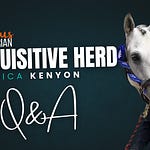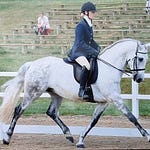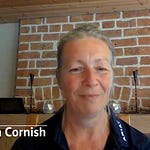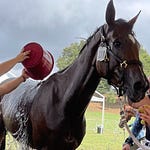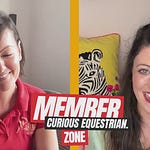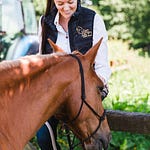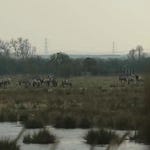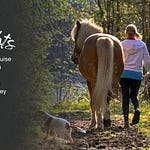Rupert Isaacson didn't set out to create a revolutionary equine therapy program for autism spectrum disorder. The journalist and lifelong horseman was simply following his autistic son's lead when three-year-old Rowan ran under the hooves of Betsy, a neighbour's quarter horse mare. What happened next changed everything.
"Whatever line he had to her was completely different to what I understood the human relationship with horses to be. This is on a whole other level."
Instead of spooking at the child, Betsy gently pushed other horses away, backed off, and began to explore Rowan with her muzzle. Isaacson observed something remarkable passing between them, a direct line of communication that defied everything he thought he knew about horse-human connections.
"There was this direct thing passing between them," Isaacson explains. "Whatever line he had to her was completely different to what I understood the human relationship with horses to be. This is on a whole other level."
The Accidental Discovery
When Rowan was diagnosed with autism at age three, the prognosis was bleak. He had regressed at 18 months, losing words and seeming to float away. Doctors offered little hope, and therapies were expensive with uncertain outcomes.
Isaacson, applying his journalistic instinct to ask questions rather than accept defeat, sought advice from Dr. Temple Grandin, professor of Animal Science at Colorado State University. Her advice became his north star: follow the child, get out in nature, and let them move.
It was during one of those nature outings, a foraging expedition, that Rowan encountered Betsy. Soon, daily visits to the horse became part of their routine, with Rowan lying on her back while she grazed, his typically agitated behaviour suddenly calm.
The breakthrough moment came during their first ride together, with Rowan sitting in front of his father in a Western saddle. As they rode past a pond, a blue heron took flight, and Rowan said, "Heron" —appropriate, communicative speech that his speech therapist had deemed unlikely just days earlier.
The Science Behind the Magic
What Isaacson didn't understand at first, but later learned from neuroscientists, was the profound effect that specific horseback movements were having on his son's brain.
"Through no intelligence of your own," one neuroscientist told him, "you've accidentally stumbled into a way to turn off what neuroscientists call the cell danger response of the brain."
The collected, rhythmic movements of the horse, particularly the soft, rocking motion of collected gaits like the Western jog or gentle lope, were triggering the production of oxytocin, the antidote to cortisol (the stress hormone that inhibits communication and learning).
Isaacson explains: "It's these collected rhythms because what they're doing is they're rocking the hips in such soft rhythm that they're causing the body to produce the antidote hormone to cortisol, which is oxytocin."
This oxytocin effect, combined with the production of BDNF (Brain-Derived Neurotrophic Factor), which Isaacson describes as "miracle growth for the brain," created optimal conditions for learning and communication.
Horse Riding Therapy: The Mongolia Journey
Isaacson's observations led to a radical decision, a horseback journey across Mongolia to visit traditional shamanic healers. This adventure, documented in his book and film The Horse Boy, wasn't about "curing" autism but about following the path that seemed to be working for his son.
"When you find that God has put his boot or her boot to your arse and kicked you firmly outside the box, you're going to look for outside-the-box stuff, because you are no longer in the box," Isaacson says.
During their Mongolian journey, Rowan connected with shamanic healers. After their final healing session in remote Siberia with a reindeer herder shaman, Rowan experienced a breakthrough, his first intentional toileting, a moment Isaacson compares to "watching England win the World Cup."
"It's always a play date. What kid wants therapy? The therapy should be invisible to the kid."
Beyond Therapy: A Philosophy of Following
What began as a father's quest evolved into a comprehensive approach that goes far beyond traditional therapy. Isaacson emphasizes that their methods aren't about forcing children onto horses but creating environments where connection can happen naturally.
"We never call the sessions therapy," he says. "It's always a play date. What kid wants therapy? The therapy should be invisible to the kid."
This approach extends to the entire family. Siblings get their own activities, riding lessons if they like horses, or football coaching if that's their preference. Parents connect with other parents, finding community and sharing information.
The horses themselves live largely natural lives, moving freely between shelter and pasture, and enjoying varied work that includes not just therapy sessions but dressage, jumping, trail riding, and what Isaacson calls "crazy time"—loose schooling with obstacle courses that keep them mentally stimulated.
Dressage in Nature: Rethinking Tradition
Isaacson's experience has transformed his own relationship with horses, leading him to develop a program called "Dressage in Nature" that takes classical training out of the arena and into the world.
"We just go out and we'll take beautiful pictures of you, like piaffing under that lovely tree or doing your tempi changes coming up that lovely hill with the old church behind you," he explains. "And just play with it and have fun with it."
This approach reflects his belief that arenas, while useful for specific training purposes, can be inherently pressure-filled environments. By contrast, taking dressage into nature transforms it from a stress-inducing discipline into a joyful art.
For those who must use arenas, Isaacson suggests creative transformations—turning them into "forests" with disgared Christmas trees, or creating "beaches" complete with towels, let your imagine run and create fun spaces for humans and horses.
The Horseboy Method
Today, Isaacson's approach has evolved into three distinct but related programs:
The Horseboy Method - Using horses to help children with autism and their families
Movement Method - Achieving similar results without horses, using movement in nature
Takhine - Preparing horses for therapy through groundwork, lunging, and long-reining
With over 100 locations worldwide, these programs maintain the core principles Isaacson learned from Dr. Grandin: follow the child, work in nature, and keep moving.
"If it had been about balloons and bicycles with him, I'd have done that," Isaacson says of his son. "And the book would have been called the Balloon Boy."
Beyond "Cure": A Different Understanding
Now 23, Rowan leads a fulfilling, independent life, travelling alone across the Atlantic, working in a state park, volunteering at a food bank, and occasionally helping his father with trainings.
"Rowan is still autistic. He'll always be autistic to the day he dies," Isaacson emphasizes. "But he's brilliant... and totally functional at the same time. It's a parallel path."
This perspective reflects Isaacson's broader philosophy: the goal isn't to eliminate autism but to alleviate suffering and unlock potential.
"You're not looking to stop the autism at all because the autism is brilliant. It's amazing. It's fantastic. There's so many qualities and gifts in it," he says. "What you're trying to do is alleviate suffering."
Equine Therapy: Horses as Healers for Autism
For those interested in exploring this path, Isaacson offers a recommendation that seems to encapsulate his entire approach: don't limit yourself to just one method.
"If you're going to want to do some sort of equine-assisted thing, we're absolutely here to help you, but we're certainly not going to say you should only do our programs," he says. "No, you should do about five or six different ones."
This openness to multiple approaches reflects the fundamental insight that has guided Isaacson since that first moment between Rowan and Betsy—sometimes, the most profound connections happen when we follow, rather than lead.
For more information about The Horse Boy Foundation and Rupert Isaacson's equine therapy treatments for autism spectrum disorder, visit New Trails Learning Systems or Helios Harmony. These therapeutic riding programs offer support for autistic children and their families through evidence-based equine assisted therapy approaches.







